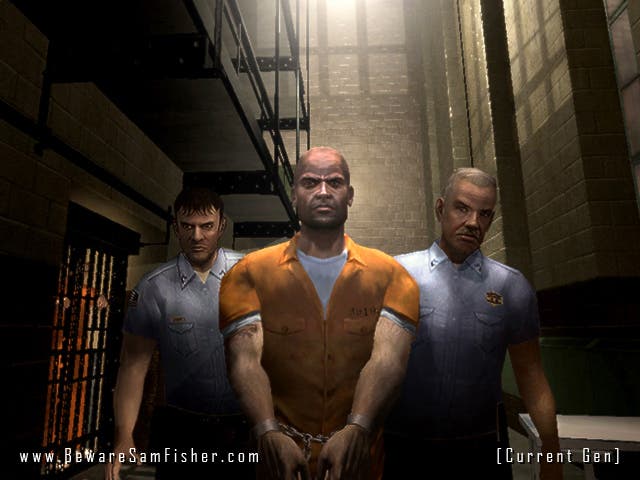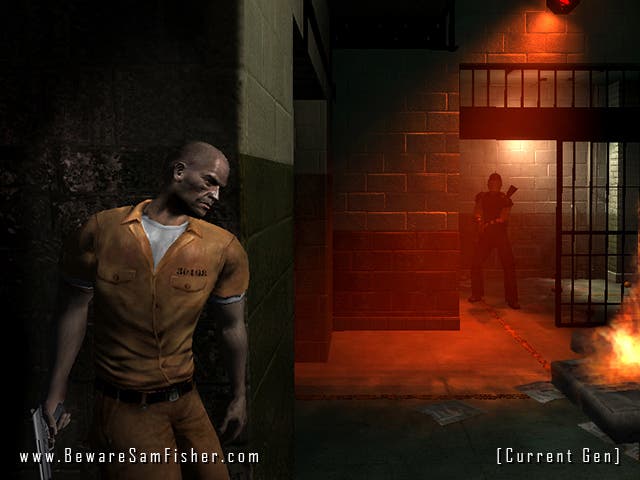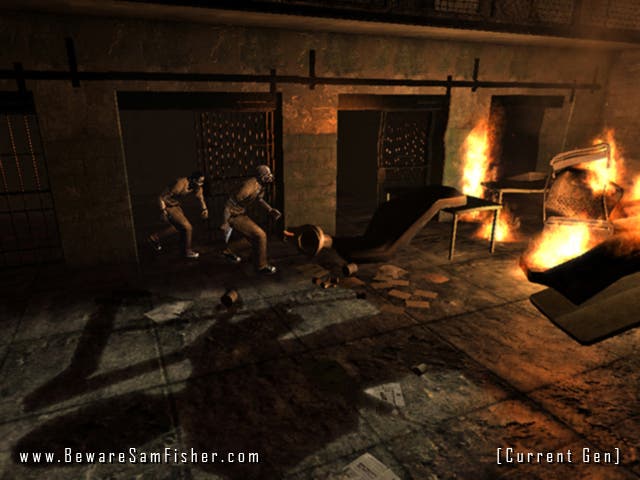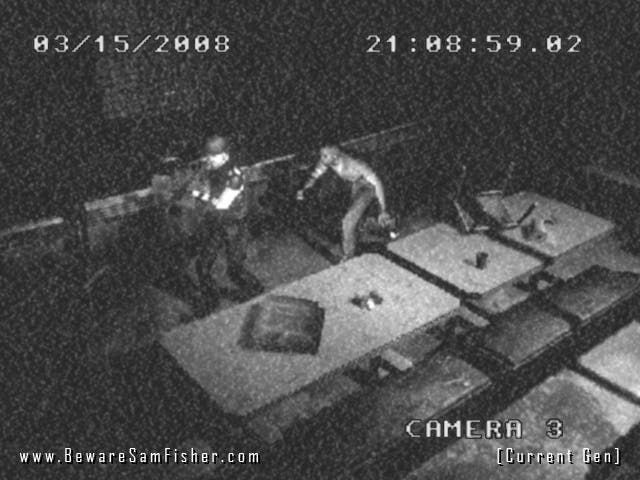Splinter Cell Double Agent
A sneak peek at the Xbox 360 version.
Sam Fisher's daughter is dead, and understandably he's not too happy about it. But what's a special agent to do when faced with personal tragedy other than throw himself into his work, entirely abandoning his former life in the process?
So begins the Xbox 360 version of Splinter Cell Double Agent, which we're being shown by co-producer Julien Gerighty and designer Chris Smith. They explain that the game starts after Sam has been selected by the National Security Association to become an NOC agent.
NOC, in case you didn't know, stands for Non Official Cover, which means agents go completely underground and sever all ties to their past. They exist only to gather information which will help to bring the enemy down, and they don't make many friends along the way.
Which is fine by Fisher, who's struggling to cope after his daughter's fatal car accident. As Gerighty explains, Splinter Cell Double Agent will show us a much more human side of Sam and give us more information about his personal life - "It's the chink in his armour."
Armour is not something Sam possesses much of in Double Agent. Quite early on, the team says, they decided it was necessary to break the poor fella - to take away his tools and weapons and put him in a situation where he's not the one in control.
Hence you won't see much of his trademark night vision goggles. "This is an indication of where we're going," says Gerighty. But remain calm, purists, the goggles do pop up in a few levels. And besides, Sam looks very fetching in his brand new aviators.
Crime and punishment
However, he doesn't even get so much as a pair of shades to play with in the game's first level, which is set in a prison. Sam's there because he's been convicted of armed robbery - only he didn't do it, of course; it's all just a ruse so he can make embark on a mission to infiltrate a terrorist group known as John Brown's Army.
Sure enough, Sam befriends a fellow inmate who just happens to be a member of the JBA, and the new chums set about planning their escape. They manage to pull it off after there's a riot in the prison and they seize control of a news helicopter, and next thing you know Sam's being introduced to his new terrorist family at the JBA headquarters.
This is where things start to get interesting, since it's where one of the game's major elements comes into play; throughout Double Agent, you'll be forced to make moral choices, and your actions will directly affect what happens next and how other characters respond to you.
So, it's time to make the first decision. The JBA has managed to capture the helicopter pilot, and now he's kneeling in front of you, bound and pleading for his life. A member of the JBA hands you a gun and orders you to shoot the man in order to prove your allegiance to the group.
Now, this bloke is merely an innocent bystander, and more importantly a journalist, and thanks to some excellent animation and voice acting it's hard not to feel persuaded by his pleas for mercy. But if you don't shoot him, you risk blowing your cover and could end up dying yourself. So what do you do?
Well, according to the development team, in playtests around 70 per cent of players chose to spare the journalist's life. Since we don't want to unleash any spoilers, let's just say it's interesting to see the outcome of your decision - whichever one you make.
Decisions, decisions

The moral choices you have to make get harder and more complex as the game progresses. At one point, for example, you'll have to decide whether you're going to sacrifice one person in order to save 3000 - not such a difficult choice, you might think, but what if that person was someone close to you? A member of your family, say, or someone who's voluntarily touched your privates?
All this is compounded by the fact that you're constantly dealing with dual objectives. The more of the terrorists' dodgy missions you carry out, the more you'll earn their trust, and the more information they will share with you, and you'll also get to access new areas in their HQ. But the NSA is constantly chucking missions at you, too, and if you get rumbled by the JBA whilst carrying out one of these, things will get very tricky.
To illustrate this, the development team shows us a level set in nighttime Shanghai which is exclusive to the Xbox 360 version of the game (although other platforms will get their own exclusive levels, too). Sam has just been accepted into the JBA, and he's accompanying them to an important meeting which is taking place on the roof of a skyscraper.
The view over Pudong is stunning - it's all soaring buildings, neon lights and, er, advertising billboards, of which more later. Smith explains that this level takes place during Chinese New Year, so in the finished game the sky will also be lit up by brilliant bursts of fireworks. There's already a huge amount of environmental detail in place, however - we particularly like the way the rain falls in sheets and bounces perfectly off Sam's freshly shaven head.
Double jeopardy
But back to the mission. The JBA have tasked Sam with keeping a lookout from way up on the highest point of the roof while their meeting takes place. Only problem is, the NSA is insisting that he somehow finds a way to record the entire conversation.
So what better way to get up close and personal than by dangling extremely precariously from a flagpole before jumping onto a window cleaner's platform and throwing its unfortunate occupant to his doom. It's important to hold on tight, though, since Sam is constantly being buffeted by high winds, and you'll need to use precision control to avoid death by concrete.
That's all they're showing us of the Shanghai level, but now Sam has moved on to Kinshasa, where a bunch of rebels have just launched a violent attempt at overthrowing the government. Hence there's carnage in the streets with bullets flying, buildings exploding and trigger-happy rebels battling it out with grenade-lobbing soldiers wherever you look.
The entire Kinshasa level takes place in broad daylight, which the development team explains was very much a conscious decision; they decided that although lurking in shadowy corners and skulking down dark corridors should always be a part of any Splinter Cell game, it was also time for a bit of a change.
But just because there's no dinginess to hide behind doesn't mean there's no cover at all. In fact, there's more and more cover as you progress through the mission, since as buildings are destroyed bits of debris end up flying all over the place. It's your job to react dynamically and make the best use of your environment even as it changes shape.
Multiple choice

It all ties in with one of the development team's key objectives; they didn't just want to create bigger environments in Double Agent, but to give you many more options in terms of how missions can be achieved. That doesn't just mean multiple paths through levels - it's more about working out how you want to complete different objectives, and finding out which methods work best for you.
You also get the option to take on extra side-missions which earn you points and improve your ranking, and often the "moral dilemma" element will come into play here too. In the Kinshasa level, for example, you spot a kid who's trapped in an overturned bus with flames licking up the sides. His mother is screaming at you to help, but there's a choice to be made here. Hanging around to sort it all out could waste valuable time and risk attracting your enemies' attention, but can you really leave the poor beggar to face his fiery doom? More importantly, can you really do without the extra points?
The team also uses the Kinshasa level to demonstrate how clever your enemies are. "All the characters you can see have highly developed AI," Smith explains, adding that they all fight intelligently and independently of each other. "To test it, we set a group of people in the Kinshasa level fighting each other and left them to it overnight. By morning, there was one guy left."
Character building
Moving on, it's time for a quick demonstration of some of the characters featured in the game. There are 176 in total, and every single one has been designed individually - you won't spot any swapping round of heads and bodies here.
This is quite an achievement when you consider that it takes a whole week to create one character. All of their facial features, bodies and clothes are individually modelled, and professional clay sculptors and life models were drafted in to ensure the highest level of realism.
Sam himself is more detailed than ever before - his head alone is made up of three thousand polygons, which is what was used for an entire character in previous Splinter Cell games.
It isn't just the characters which have been given a graphical overhaul - the developers also paid particular attention to the in-game lighting and how it reflects off different surfaces. Leather appears dramatically different, for example, to plastic or metal - just as it should, of course.
There's been a focus on getting the animations perfect, too, and once again they've drafted in specialists to help out; one of the artists working on the game was previously responsible for animating one of the triplets in hit French film Les Triplettes de Belville.
Techno techno techno

The Xbox 360's advanced technology has also allowed the team to make plenty of changes to the gameplay, but Gerighty explains that they are firm believers in "Not using technology for technology's sake."
Now you'll see Sam performing a greater variation of actions than ever - he goes swimming and skydiving, for example - but the team was determined that these elements "couldn't just be in there for the sake of it; they had to fit in with the Splinter Cell series."
Which means Sam will have to make use of his more familiar talents, such as stealthy approaches, even when he's trying out his new skills. So, for example, there's a level set in the Arctic where Sam is able to cut a hole in the ice and swim undetected through the freezing waters beneath. If he spots an enemy lurking above, he can cut open another hole, reach up and pull the poor unfortunate down into the icy depths quick sharp.
It all contributes to our overall impression that Double Agent is indeed a much bigger, deeper game than previous instalments in the Splinter Cell series - as both Gerighty and Smith are keen to point out, "It's not just Chaos Theory 2." They say that a lot.
IP freely
What with all these changes to both the game and Sam's character, we can't help wondering why they didn't just forget the whole Splinter Cell thing altogether start all over with an entirely new IP. So, we ask, why didn't you just forget the whole Splinter Cell thing altogether start all over with an entirely new IP?
"It almost is a new IP," Smith explains. And they had to ensure that was the case, since the development teams had already worked on three Splinter Cell games - which meant they were at risk of getting bored, and therefore at risk of producing a boring game.
Smith says the inspiration for taking the series forward came from Resident Evil 4, which he started playing one night and was still playing the following dawn. He's full of admiration for the way Resi 4 took the series in a new direction and still ended up being a brilliant game - and that's what he and the team are trying to do with Double Agent.
Ads infinitum

One similarity with previous games, however, is that Double Agent does feature in-game advertising, which isn't good news for those who didn't enjoy being encouraged to buy chewing gum in previous games. We didn't spot any Wrigley's ads, but there was a prominent Nivea billboard on one of the skyscrapers in the Shanghai level. Don't tell us we'll be watching Sam slap on a bit of Revitalising Eye Relief Q10 between missions?
Absolutely not, says Smith. Yes, Nivea is the game's biggest sponsor, and there will be adverts, but these will be implemented "subtly and realistically" - Smith cites the blatant product placement in "I, Robot", where the character played by Will Smith (no relation) (probably) shows off his Converse boots, as an example of what the team is desperately trying to avoid. Unfortunately, there's no getting round the need for a bit of in-game advertising, Smith says - "It's a financial reality of development costs today."
So that's it for now - yes, we're told, the multiplayer mode is shaping up very nicely thank you, but it's being kept under wraps for now. Just time for one or two more cheeky questions; so when's the PS3 version coming out, then?
It's a "No comment" on that one, unsurprisingly. But Smith does add: "If there was going to be a PS3 version, I would love to work on it."
What about the Splinter Cell movie - is there anything the team can share with us? Well, apparently Ubisoft has been approached by lots of Hollywood studios who want to take charge of the film, but they're making their decisions carefully. "They don't want another Alone in the Dark," we're informed, and frankly who does. The good news, we can now confirm, is that Uwe Boll will definitely not be allowed to have anything to do with the Splinter Cell film. Manners.


